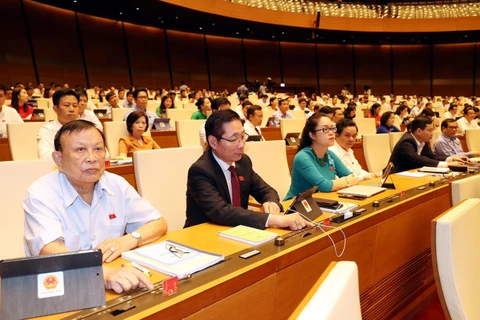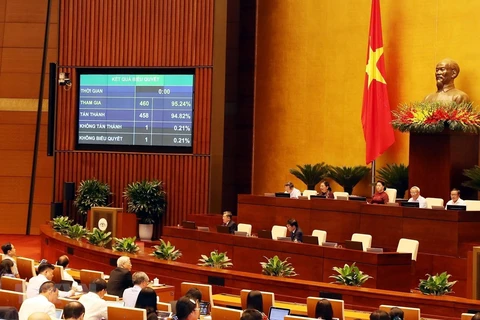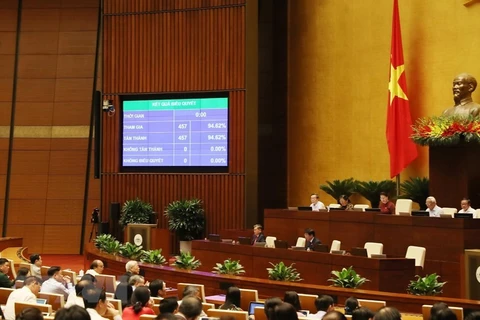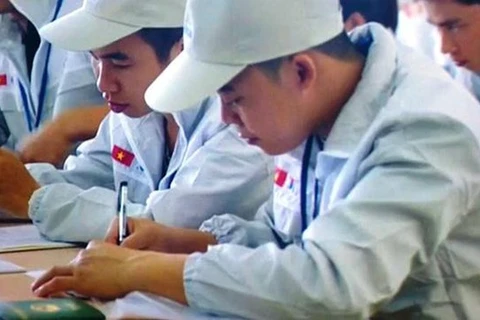 Workers losing jobs due to the COVID-19 pandemic make procedures to get unemployment allowances (Photo: VietnamPlus)
Workers losing jobs due to the COVID-19 pandemic make procedures to get unemployment allowances (Photo: VietnamPlus) Hanoi (VNA) – The COVID-19 pandemic has caused turmoil in the labour market, with massive job and income losses in the first half of 2020 and the recovery in the second half will be uncertain and incomplete, the International Labour Organisation (ILO) has warned.
In its fifth edition of the “ILO Monitor: the world of work” published recently, the organisation said that the closure of workplaces and implementation of other containment measures, combined with the rapid deterioration of economic conditions, led to immediate and massive losses in working hours over the first half of 2020.
During the first quarter of 2020, an estimated 5.4 percent of global working hours (up from 4.8 percent as estimated previously) were lost relative to the fourth quarter of 2019, equivalent to 155 million full-time jobs.
The latest estimates presented in this edition of the ILO Monitor reveal a decline in global working hours of 14 percent in the second quarter of 2020 (up from the previous estimate of 10.7 percent), which is equivalent to 400 million full-time jobs.
Three scenarios for the second half of 2020
The latest statistics showed that the situation have been worsening over the past weeks in many regions, especially in developing economies.
By region, the Americas is estimated to have suffered a reduction in working hours of 18.3 percent, or 70 million full-time equivalent (FTE) jobs, in the second quarter of 2020, compared with the previous estimate of 13.1 percent. This is the highest working-hour loss among the major geographical regions and the largest upward revision since the fourth edition of the ILO Monitor. Within this region – and among all regions and subregions of the world – South America has the highest estimated working-hour loss in the second quarter, at 20.6 percent. Losses for Central America and for Northern America are estimated at 19.2 and 15.3 percent, respectively.
The hours worked in Europe and Central Asia are estimated to have declined by 13.9 percent, or 45 million FTE jobs, in the second quarter, up from the estimate of 12.9 percent presented in the previous edition of the ILO Monitor. The largest loss in this region is estimated to have occurred in Southern Europe (18.0 percent), followed by Northern Europe (15.3 percent), Western Europe (14.3 percent), Central and Western Asia (13.6 percent) and Eastern Europe (11.6 percent).
In Asia and the Pacific, the total working-hour loss for the second quarter of 2020 is estimated at 13.5 percent, or 235 million FTE jobs, up from the previous estimate of 10 percent. Among the subregions, the greatest reduction in working hours is estimated to have occurred in Southern Asia (with a decline of 17.9 percent in the second quarter) followed by South-Eastern Asia and the Pacific (12.6 percent) and Eastern Asia (10.4 percent).
Working hours in the second quarter of 2020 are estimated to have declined by 13.2 percent, or 8 million FTE jobs, in the Arab States, an upward revision of 2.9 percentage points from the estimates presented in the previous edition of the ILO Monitor.
In Africa, the total working-hour loss in the second quarter of the year is estimated at 12.1 percent, or 45 million FTE jobs, up from the previous estimate of 9.5 percent. In terms of subregions, estimates for working-hour losses in the second quarter of 2020 indicate that Northern Africa experienced the sharpest decline (15.5 percent), followed by Southern Africa (12.2 percent), Central Africa (11.9 percent), Western Africa (11.6 percent) and Eastern Africa (10.9 percent).
Taken together, the vast majority, namely, 93 percent, of the world’s workers continue to reside in countries with workplace closure measures of some kind still in force. There are significant variations in workplace closures across regions. The region currently most affected by restrictions on workers and workplaces is the Americas.
The report mapped out three scenarios for recovery in the second half of the year: baseline, optimistic, and pessimistic.
In the baseline scenario, the loss of global working hours would decline from the peak in the second quarter of 2020 to 4.9 percent in the fourth quarter, or 140 million FTE jobs (assuming a 48-hour working week). This means that labour markets are likely to be far from fully recovered by the end of 2020.
In the pessimistic scenario, the situation in the second half of 2020 would remain almost as challenging as in the second quarter. Even if one assumes better-tailored policy responses – thanks to the lessons learned throughout the first half of the year – there would still be a global working-hour loss of 11.9 percent at the end of 2020, or 340 million FTE jobs, relative to the fourth quarter of 2019.
The optimistic scenario would push the working hour loss down to 34 million FTE jobs by the end of the fourth quarter of 2020, a gap of 1.2 percent relative to the fourth quarter of 2019.
Protecting vulnerable groups
The report pointed out that the COVID-19 crisis threatens to undo some of the recent gains in gender equality. The latest labour force survey data reveal alarming trends that threaten to exacerbate existing disparities and eliminate the modest gains achieved in recent years in terms of gender equality in the labour market.
Against the backdrop of gender inequalities in the labour market, the crisis is disproportionately affecting women workers in four main ways. First, a large proportion of women work in sectors severely affected by the crisis. Globally, almost 510 million, or 40 percent of all employed women, work in hard-hit sectors, including accommodation and food services; wholesale and retail trade; real estate, business and administrative activities; and manufacturing. This compares with a share of 36.6 percent of employed men. Secondly, women in domestic work have been highly vulnerable to containment measures. Thirdly, the overwhelming majority of workers in the health and social work sector are women. Fourthly, during the crisis, the unequal distribution of increased care demands affects women disproportionately.
Despite the extraordinary and often unprecedented measures introduced around the world, the damage done by the COVID-19 crisis to labour markets is enormous and leaves policymakers to confront major policy challenges.
The ILO suggested solutions for nations worldwide: Finding the right balance and sequence of health and economic and social policy interventions to produce optimal sustainable labour market outcomes; implementing and sustaining policy interventions on the necessary scale at a time when resources are increasingly constrained; supporting vulnerable and hard-hit groups, and generating fairer labour market outcomes; securing international solidarity and support especially for emerging and developing countries; and strengthening social dialogue and respect for rights at work.
"Next week the ILO is convening a high-level, virtual, Global Summit on COVID-19 and the World of Work. I hope that governments, workers and employers will use this opportunity to present and listen to innovative ideas, discuss lessons learned and come up with concrete plans to work together to implement a recovery that is job-rich, inclusive, equitable and sustainable. We must all step up to the challenge of building a better future of work," said ILO Director-General Guy Ryder./.

























